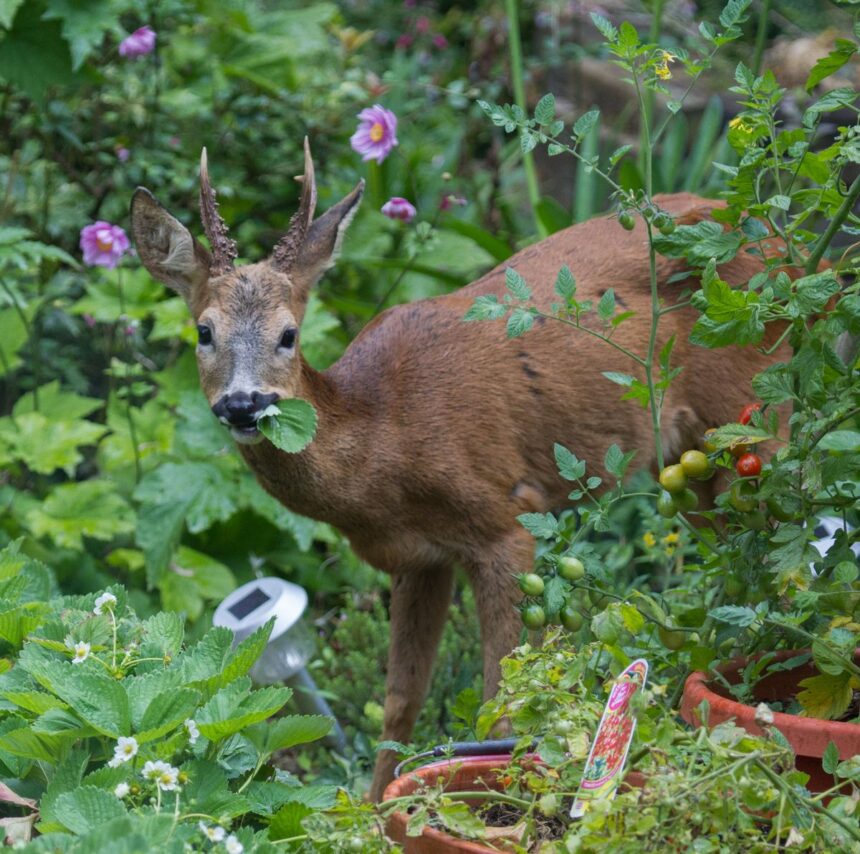If you have ever wondered how to prevent deer damage to plants and keep your garden safe, this article is for you.
The truth is, preventing deer damage to plants can be tough. These animals can jump high and fit through small spaces, causing damage to your plants.
Deer-proof gardening is more than just using fences and repellents. It’s about knowing deer behavior and making your garden less inviting. You can use deer-resistant plants and other strategies to keep your garden safe.
Did you know deer eat a lot of crops like corn and soybeans? In some places, these crops make up 78% of a deer’s diet. This shows how important it is to manage deer habitats well. With the right tips, you can enjoy a beautiful garden and live in harmony with wildlife.
Understanding Deer Behavior And Feeding Habits
To control deer damage to plants or prevent browsing, we must understand their behavior. Deer eat about 6 to 8 pounds of food every day.
They look for plants in forest edges and open areas. This often brings them to our gardens in search of food.
Seasonal Dietary Changes
Deer’s diets change with the seasons. In spring and summer, they eat fresh growth and herbaceous plants. Come fall, they prefer nuts and fruits. In winter, they eat any vegetation they can find, including evergreen shrubs.
Deer Preferences And Foraging Patterns
Deer like herbaceous perennials, vegetables, and fruit trees. They tend to avoid plants with fuzzy, coarse leaves or strong scents.
They often feed at night but will eat during the day if they’re hungry. Using repellents and rotating them can help, as deer can change their preferences based on what’s available.
Impact Of Environmental Stress On Deer Feeding
Deer will eat more when the environment is stressed, like during drought or overpopulation. In harsh winters, they move to safe areas for food and shelter. Spring makes the amount of damage in gardens worse as they look for nutritious food after a long winter.
- Fencing (8+ feet tall)
- Electric fences
- Repellents (natural or commercial)
- Deer-resistant plants
- Scare tactics (noise makers, sprinklers)
To prevent deer damage to plants, there needs to be a mix of strategies. No plant is completely safe from deer, but knowing their habits can help protect your garden.
Identifying Deer Damage In Your Garden
Spotting deer damage early can help protect your deer resistant plants. Deer leave distinct signs that set them apart from other wildlife. By learning these clues, you can take swift action with effective Deer Deterrents.
Characteristics Of Deer Browsing
Deer damage to plants has a unique look. They tear leaves and twigs, leaving rough edges. Deer prefer branches under one inch thick.
In fall, male deer rub their antlers on trees, stripping bark. This can be worse than eating plants.
Distinguishing Deer Damage From Other Wildlife
Rabbits and rodents damage plants differently. They make clean, angled cuts. Rabbit bites are wider, while rodent marks are narrow. Deer leave ragged tears instead of clean cuts. This helps you pick the right deer deterrents that can help prevent deer damage to plants in your garden.
Signs Of Deer Presence In Your Landscape
Look for these clues that deer are visiting:
- Droppings: Deer leave distinct pellets
- Tracks: Hoof prints in soft soil or snow
- Bedding areas: Flattened grass where deer rest
- Bark damage: Rubbed or stripped bark on trees
Knowing these signs helps you protect your garden. You can choose the right way to prevent deer damage to plants by using targeted Deer Deterrents to keep your landscape safe.
Preventing Deer Damage to Plants
Deer-proof gardening starts with knowing deer behavior. The U.S. deer population has grown from 500,000 to 15 million since the early 1900s. This means more deer are now in our gardens. Let’s look at ways to keep your plants safe.
Start by choosing deer-resistant plants. Plants with prickly, fuzzy, or strong smells are less appealing to deer. Juniper, Bayberry, and Spirea are good choices. Herbs like Lavender, Sage, and Thyme also keep deer away.
Use deer repellents often for the best effect. Commercial repellents contain putrescent egg solids or dried blood. Or, make your own mix with bovine blood, eggs, garlic, and dish soap. Spray this on your plants to deter deer.
Physical barriers work well too. Put an 8-foot fence around your garden. For smaller areas, use welded-wire fences with top enclosures. Buried fencing can protect vegetable gardens from deer.
Deer can change their eating habits. They might start eating plants they used to ignore. Always be watchful and change your deer-proofing methods to keep your garden safe.
Deer-Resistant Landscaping Strategies
Creating a deer-resistant landscape means planning and picking the right plants. No plant is completely safe from deer, but some are less tempting. With smart landscaping, you can prevent deer damage to plants, keeping your garden safe and beautiful.
Selecting Deer-Resistant Plants
Pick plants that deer don’t like. Daffodils, boxwood, and lavender are good choices. Yarrow, Russian sage, and lamb’s ears also work well. Check with your local Agricultural Extension office for plants that work best in your area. Grouping similar plants helps hide any damage.
Creating Protective Borders and Bed Edges
To prevent deer damage to plants in your garden, you should use plants deer don’t like for borders.
Basil, garlic, and onions are good choices. Holly or roses can also help keep deer away. These plants aren’t perfect, but they can keep deer out of your garden.
Incorporating Aromatic and Textured Plants
Add plants with unpleasant smells and textures to your garden. Lavender, sage, and catmint are good for keeping deer away. These plants look nice and help protect other plants. Keep your garden diverse with different deer-resistant plants for the best results.
Conclusion
By incorporating expert tips such as using plants that repel deer, installing physical barriers, and employing various deterrents, gardeners can significantly reduce the risk of deer damage to their plants.
Implementing companion planting with strong-scented herbs, creating noise or scent deterrents, and staying vigilant with regular checks and adjustments ensures a proactive approach to protecting gardens from deer.
By following these strategies, gardeners can enjoy lush, thriving plants while keeping deer at bay.








